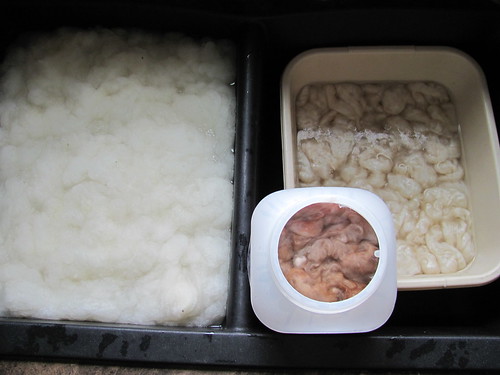I haven’t done any dyeing at home since before getting married. Once I was married, it seemed unfair to ask the other two members of the family not to eat any food in the kitchen all day because it would be contaminated by my dye. There is an extra stove in my basement, waiting to become a dye stove, but so far no one with the know-how has had time to install a 220 line and hook it up. Lately, I’ve gotten really antsy about waiting.
I finally realized that now that the boy has moved out,
whenever my husband goes on a business trip, I’m home alone, which means I have
time and opportunity to dye in the kitchen without poisoning anyone. I’ve had a project in mind for a few years
now. The various fibers have been stored
away waiting.
From l to r: Purple, navy, and green wool; purple, navy and green tussah silk; grey angora; and black wool.
The plan is to blend a heathered black. I have over 2 pounds of wool, plus 8oz of
silk and 4oz of satin angora. What isn’t
shown in the picture is that I dyed the majority of the fiber black (over a
pound and a half). The 3 other colors
together make up about a third of the total weight. I’m hoping to get a black with a dark rainbow
that shines out here and there, kind of like an oil slick.
Some observations/stuff I learned while doing this:
- · I need to dye more often! Far too much of the process was unnecessarily nerve wracking because I couldn’t remember enough from the last times I’ve dyed, like how much fiber each dye pot holds, or how quickly the dye starts absorbing.
- · Angora doesn’t take dye very well. As I watched the angora resist dye, I realized that I must have already read or seen that somewhere before. I used just as much black dye on the angora as everything else, and heated it for just as long, but it’s hardly grey. I’m not worried about this in the final project, as it’s such a small portion of the overall weight I doubt it will have any negative effect on the color. I’m hoping it’s just enough angora to add softness and a slight halo to the finished yarn.
- · Good record keeping is everything it’s cracked up to be. Even thought I haven’t dyed in ages, it was easy to figure out my color formulas based on my samples and records from previous projects.
- · It pays to clean the kitchen, weigh the fibers, and do the math the night before. Again, because I don’t do this often enough, I had to spend considerable time reviewing Color in Spinning to find the formulas for calculating how much of each assist to use. Doing the math the night before allowed me to use my dye time much more efficiently that day.
- · Wet fiber won’t dry while clumped together. Enough said.
- · I need a giant salad spinner to whip the water out of my dyed fiber using centrifugal force.
- · I want more time in my life to dye, card, and spin.
- · I really like green and purple.


